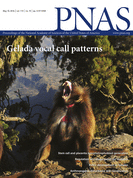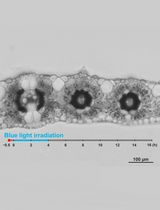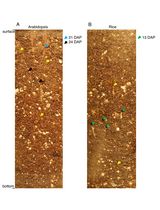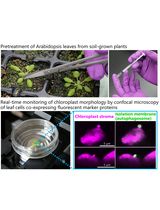- EN - English
- CN - 中文
Phototaxis Assay for Chlamydomonas reinhardtii
莱茵衣藻的趋光性分析
发布: 2017年06月20日第7卷第12期 DOI: 10.21769/BioProtoc.2356 浏览次数: 15184
评审: Maria SinetovaAgnieszka ZienkiewiczAnonymous reviewer(s)
Abstract
Phototaxis is a behavior in which organisms move toward or away from the light source (positive or negative phototaxis, respectively). It is crucial for phototrophic microorganisms to inhabit under proper light conditions for phototaxis. The unicellular green alga Chlamydomonas reinhardtii rapidly changes its swimming direction upon light illumination, and thus is a nice model organism for phototaxis research. Here we show two methods to assay Chlamydomonas phototaxis; one is a quick, easy and qualitative analysis, so-called the dish assay; and the other is a quantitative single-cell analysis.
Keywords: Phototaxis (趋光性)Background
The unicellular green alga Chlamydomonas reinhardtii is used as a model organism in various research fields including phototaxis of microorganisms, photosynthesis, and ciliary/flagellar motility (Hegemann and Berthold, 2009). A Chlamydomonas cell perceives light at its eyespot, the photoreceptive organelle observed as an orange spot located near the cell equator. The eyespot contains the photoreceptor proteins channelrhodopsins localized in the cellular membrane and the carotenoid-rich granule layers right behind the channelrhodopsins which function as a light reflector. Because of their relative position, the eyespot undergoes highly directional photoreception, and the cell can accurately detect the direction of light illumination (Foster and Smyth, 1980; Ueki et al., 2016). Upon photoreception, two flagella change their beating balance, and the cell changes its swimming direction either toward or away from the light source.
The Chlamydomonas phototactic direction (or ‘sign’) is regulated by cellular reduction-oxidation state, which is affected by cellular metabolism such as photosynthetic and respiratory activities (Wakabayashi et al., 2011). The phototactic sign thus indirectly reflects those activities in vivo. For instance, a mutant showing fast phototactic response has been shown to have high photosynthetic activity (Kim et al., 2016). In addition, for the regulation of flagellar beating for phototactic turning of the cell, flagellar dyneins should be strictly regulated (Kamiya and Witman, 1984; Okita et al., 2005; Hegemann and Berthold, 2009). Therefore, phototaxis assay contributes to a wide variety of biological researches, such as photoreception, photosynthesis, respiration, and motor proteins.
Various methods have been developed to quantify Chlamydomonas phototaxis. Mergenhagen developed an automatic assay system for phototaxis (photoaccumulation), which detects the density of cells in the light path by a photocell (Mergenhagen, 1984). Takahashi et al. developed a computer-assisted system that automatically detects the direction of cellular movement using an infrared-sensitive video camera (Takahashi et al., 1991). Comparing to those sophisticated systems with hand-made equipment, our protocol is rather simple, and can be carried out with equipment that is commercially or freely available.
Materials and Reagents
- 50 ml tube (Thermo Fisher Scientific, Thermo ScientificTM, catalog number: 339652 )
- 4 cm Petri dish (AS ONE, catalog number: 1-8549-01 )
- Chlamydomonas strain of interest
- Tris-acetate-phosphate medium
- (Optional) Tertiary-butyl hydroperoxide (t-BOOH: final concentration, 0.2 mM) (WAKO Pure Chemical Industries, catalog number: 026-13451 )
- (Optional) N,N’-dimethylthiourea (DMTU: final concentration, 75 mM) (Sigma-Aldrich, catalog number: D188700 )
- HEPES (pH 7.4) (NACALAI TESQUE, catalog number: 17514-15 )
- EGTA (DOJINDO, catalog number: 346-01312 )
- Potassium chloride (KCl) (NACALAI TESQUE, catalog number: 28514-75 )
- Calcium chloride dihydrate (CaCl2·2H2O) (NACALAI TESQUE, catalog number: 06731-05 )
- Phototaxis assay solution (Okita et al., 2005) (see Recipes)
Equipment
- Centrifuge (Hitachi Koki, model: CR20GIII )
- Swing rotor (Hitachi Koki, model: R4SS )
- Green light-emitting diode (LED) (λ = 525 nm) (OptoSupply, model: OSPG5111A-VW )
- Red light (or white light with a red filter [λ > 600 nm])
- White sheet of paper/plastic
- Dark room or dark box
- Digital still camera (SONY, model: RX100II )
- Imaging table with camera mount (AS ONE, model: NS-CPS360N )
- Inverted microscope equipped with video camera (Olympus, model: IX70 ; Wraymer, model: 1129HMN1/3)
- Red filter (630 nm long-pass filter) (SCHOTT, model: RG630 )
- (Optional) Photometer (Apogee Instrument, model: MQ-200 )
- (Optional) Neutral density filters (HOYA, models: ND10AH and ND30AH )
Software
- Image Hyper (Science Eye, Japan) or any particle-tracking software (e.g., ImageJ with MTrack2 plugin)
- Microsoft Excel or any spreadsheet software
Procedure
文章信息
版权信息
© 2017 The Authors; exclusive licensee Bio-protocol LLC.
如何引用
Ueki, N. and Wakabayashi, K. (2017). Phototaxis Assay for Chlamydomonas reinhardtii. Bio-protocol 7(12): e2356. DOI: 10.21769/BioProtoc.2356.
分类
植物科学 > 植物生理学 > 表型分析
植物科学 > 植物细胞生物学 > 细胞成像
细胞生物学 > 细胞成像 > 活细胞成像
您对这篇实验方法有问题吗?
在此处发布您的问题,我们将邀请本文作者来回答。同时,我们会将您的问题发布到Bio-protocol Exchange,以便寻求社区成员的帮助。
Share
Bluesky
X
Copy link















